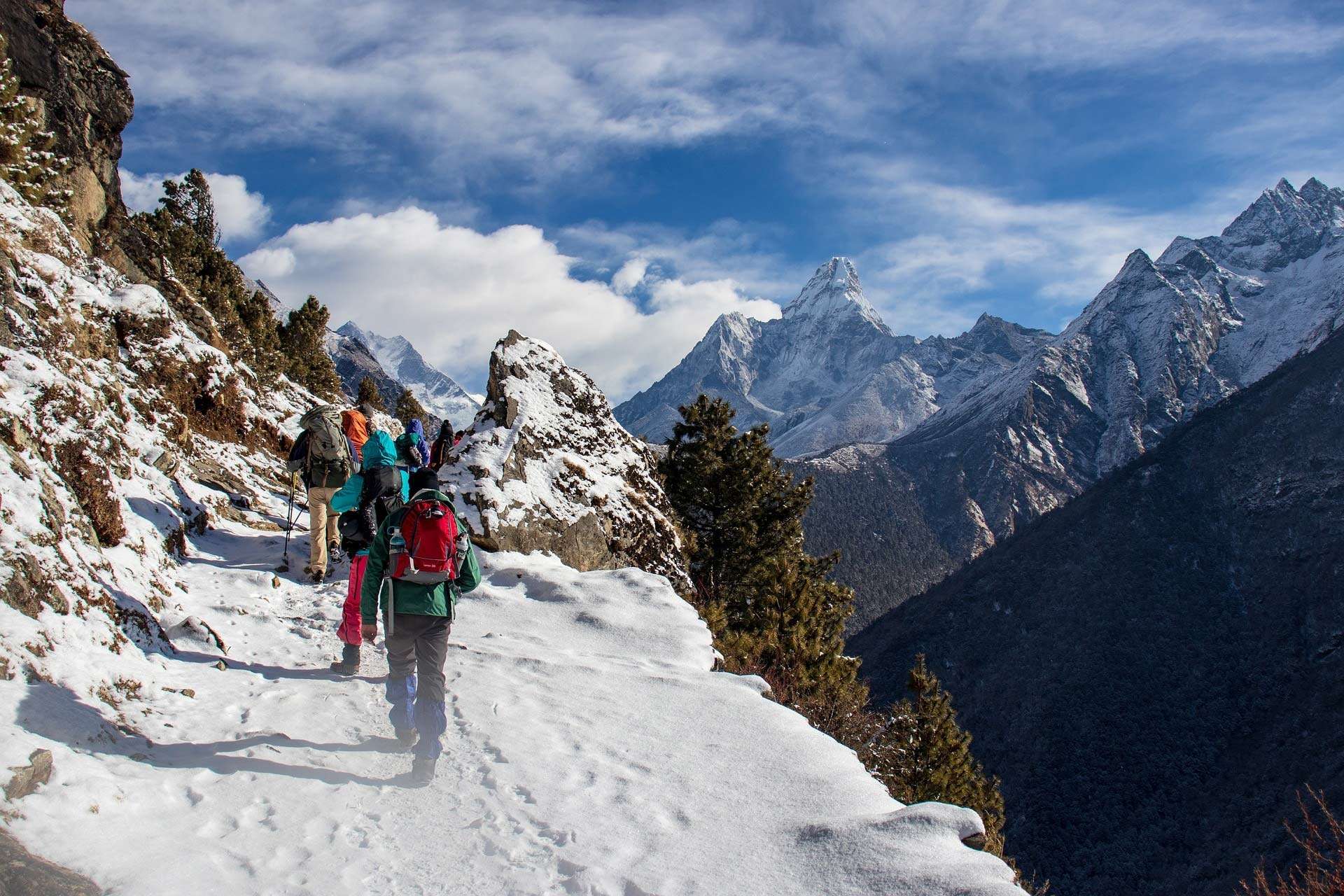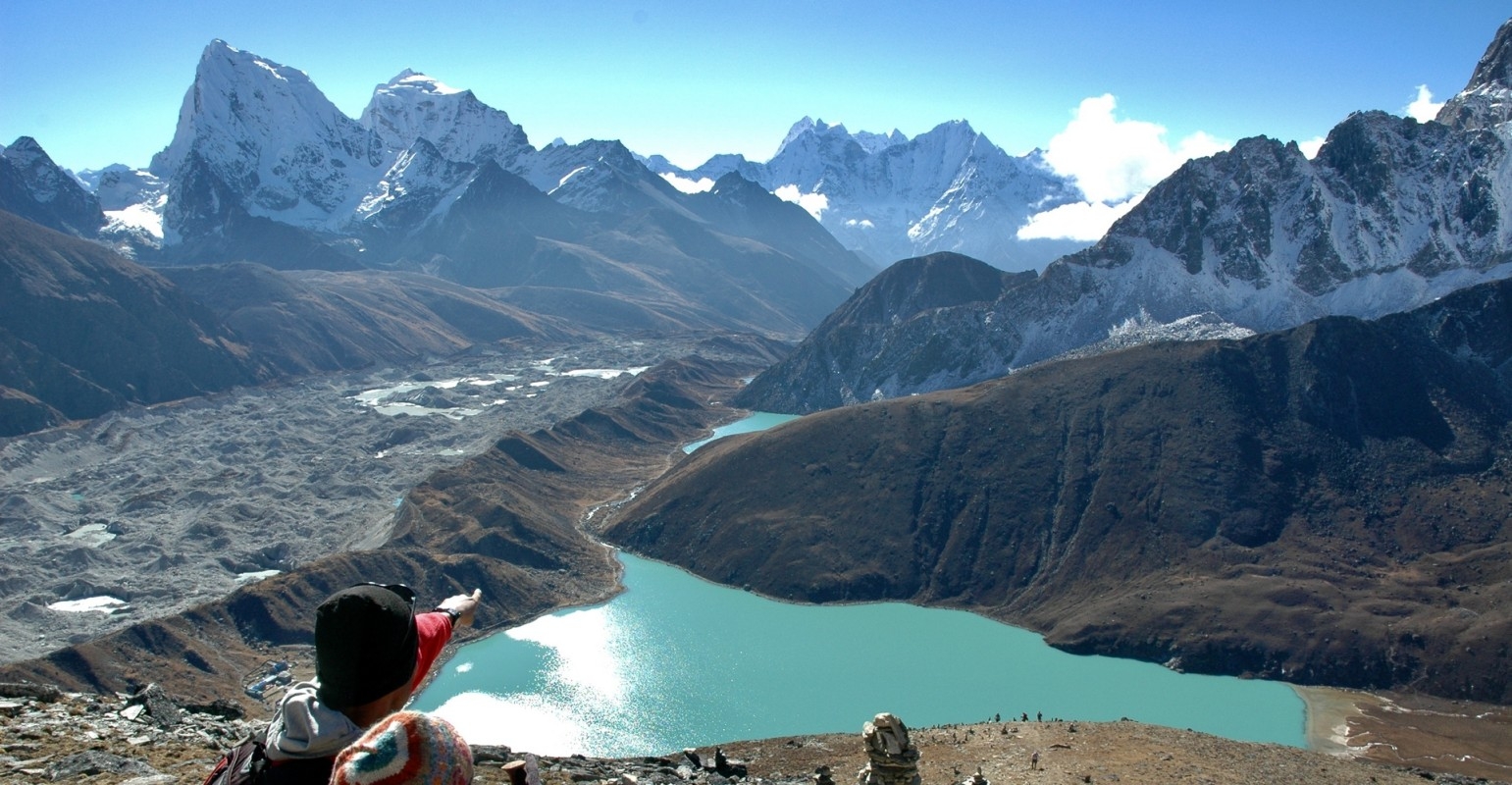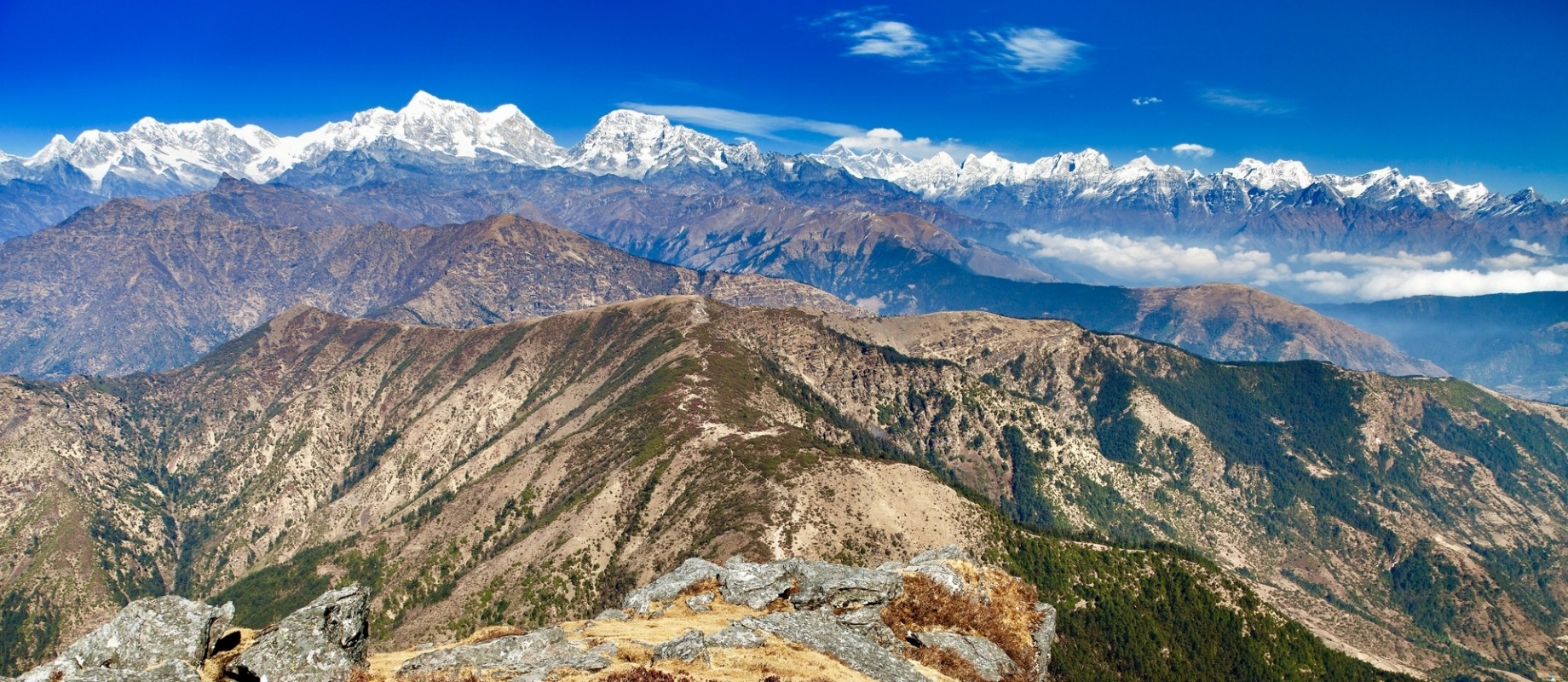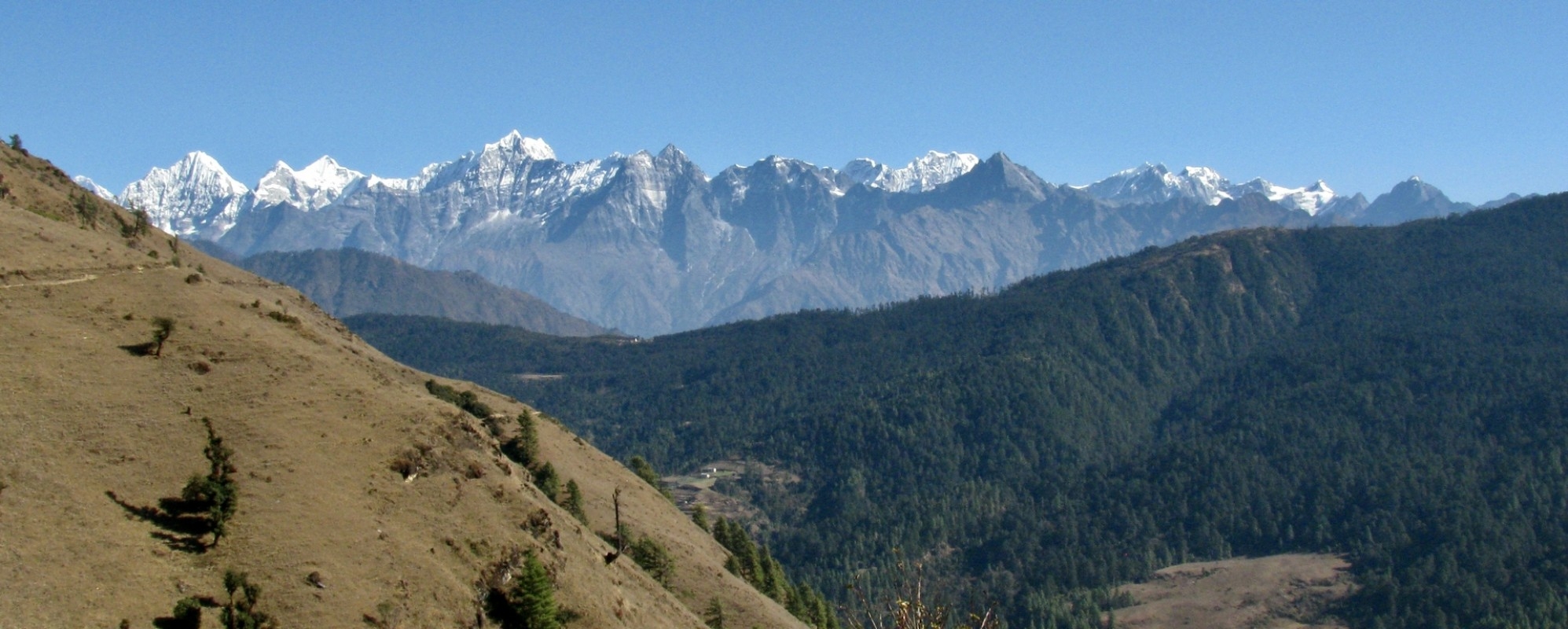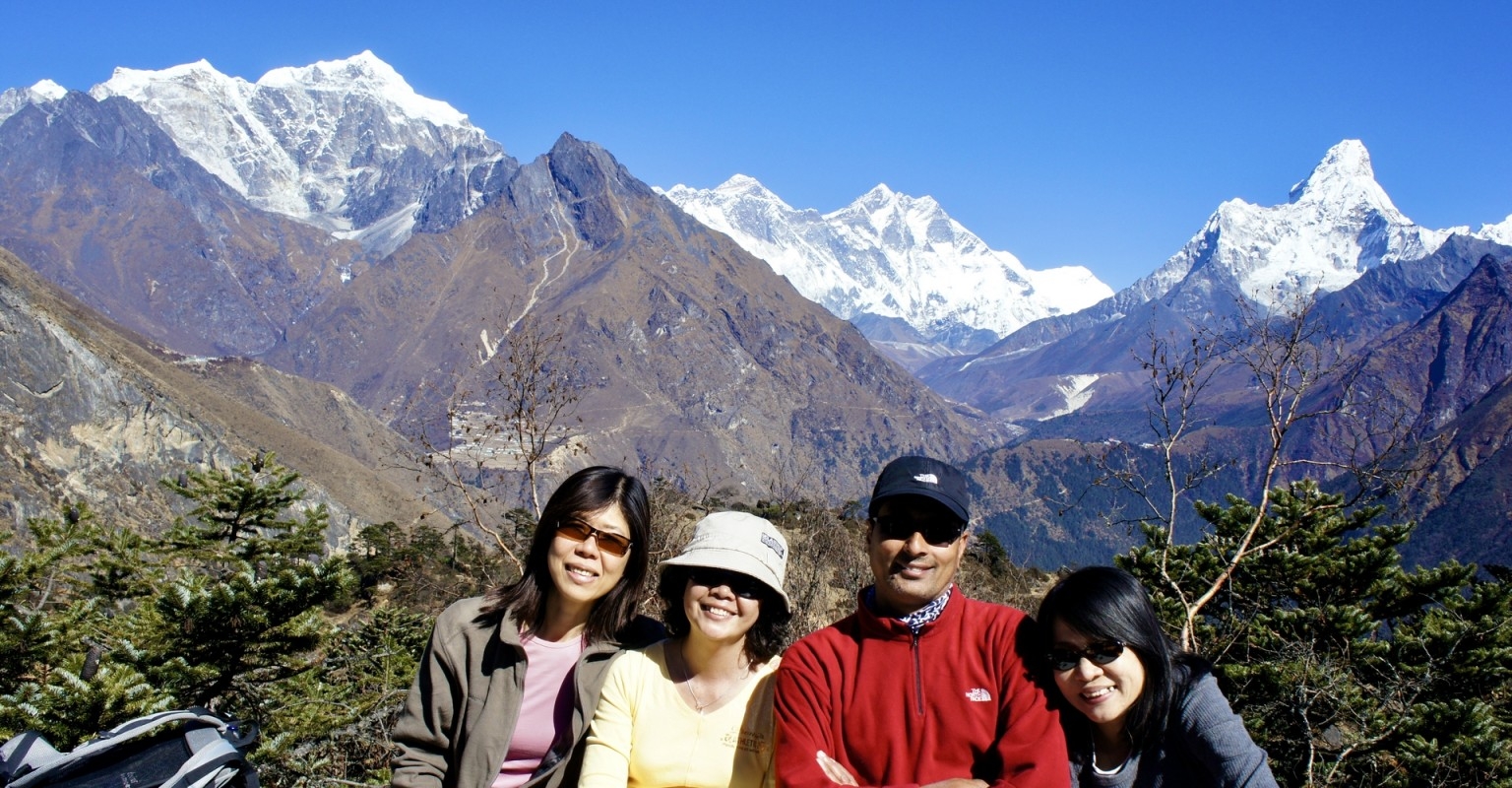

Best time to travel Nepal
Nepal is a country of differences with various landscapes, including towering mountain ranges, lush forests, and a vibrant cultural heritage. The best time to travel to Nepal depends on your preferences and the type of excursions or events you intend to participate in. Generally, Nepal has four distinct seasons, each with unique charms and challenges.
Fitness and Training
Nepal is home to some of the world's highest and most challenging High Himalayan peaks, including Mount Everest, and attracts many adventure enthusiasts who wish to trek and climb in the Himalayas. However, these activities require physical fitness and training to ensure a safe and successful journey.
Trekking in Nepal involves walking long distances, sometimes several hours a day, over varied terrain and at high altitudes. Therefore, it is recommended to start fitness activities several months before the trip, including cardiovascular exercise, strength training, and endurance training. It will help build stamina, increase lung capacity, and prepare the body for the physical demands of trekking.
beside to physical fitness, it is essential to have proper training and knowledge of high-altitude climbing and trekking techniques. It includes knowing the consequences of altitude sickness, correct breathing methods, and the usage of climbing gear such as ice axes, crampons, and ropes. It is highly recommended to undergo an introductory mountaineering course or training program before embarking on a high-altitude trek or climb in Nepal. Suitable clothing and equipment are crucial for any trip to Nepal, including sturdy hiking boots, warm clothes, a sleeping bag, and a first aid kit. Having travel insurance covering medical evacuation in an emergency is also important.
Additionally, travelers should pay attention to their bodies and take rest breaks as necessary. Acclimatization is critical to avoiding altitude sickness, so taking a rest day every few days is recommended to allow the body to adjust to the higher altitude.
Thus, physical fitness, proper training, and adequate preparation are necessary for a successful and safe journey from Nepal to Nepal. Travelers should also know the risks and challenges of high-altitude trekking and climbing and take the required safety measures to ensure a fun and safe journey.
Packing Checklist
One of the essential aspects of planning a journey in Nepal is packing the right gear, including proper clothing, equipment, and other accessories. Trekking in the severe terrain of Nepal requires adequate planning and good preparation, from backpack to luggage binding. Your packing list should be tailored to the trek you plan to undertake, the time of the year you're traveling, and your preferences.
Further, you must pack light if you carry your gear throughout the trek by not hiring a porter. It is better to rent or buy equipment in Nepal to save space in your luggage. It is also necessary to ensure your gear is high quality and in good condition, as you want to avoid any trouble in the mountains with faulty equipment. So, it is better to take our suggestions when preparing your baggage for traveling in Nepal.
Beyond all this, if you want a safe and comfortable trip to Nepal, list all the gear you need, double-check the weather forecast, and ensure you have everything you need during the journey.
About Lukla's Flight and Weather
The Lukla flight is essential to the journey to Everest Region Trekking. It provides access to the famous Everest Base Camp trek and other nearby treks. However, weather conditions in the region can often cause delays or cancellations of the flight, which can significantly impact your trekking plans. The flight is known for its thrilling experience due to challenging terrain and unpredictable weather conditions.
Lukla airport is at an altitude of 2860 meters, and the flight to Lukla from Kathmandu takes approximately 30 minutes. The flight is subject to weather conditions, and Due to low visibility, flights may be postponed or canceled in unfavorable weather conditions.
Also, Lukla Airport, due to its location, is regarded as one of the most dangerous airports in the world. Landscapes and geography. The runway is short and on a steep slope, making it a challenging landing spot for pilots. Considering these things, flights may be canceled or delayed at short notice, and travelers must be prepared to flexible with their travel plans. If your Lukla flight is canceled or delayed, there are several options, like flying in a helicopter or by ground transportation using a bus, jeep, or car. However, using ground transportation can add several days to your Itinerary.
We recommend you book the flight in advance following your Itinerary, especially during peak seasons, as the flights can fill up quickly. When you book a trekking package with us, we arrange the flights to ensure a smooth and safe journey.
Regarding weather conditions, Lukla experiences a sub-tropical climate with a 5 to 25 degrees Celsius temperature range. The most suitable period for taking the Lukla flight is during autumn and spring, when the weather conditions are favorable and visibility is optimal. During the winter months, the flight may be delayed or canceled due to snowfall or heavy fog, while during the monsoon season, it gets affected by heavy rain and cloud cover.
In conclusion, the Lukla flight is a crucial aspect of many trekking itineraries in the Everest region. Still, planning for potential delays and prioritizing safety when choosing a trekking agency and airline is essential. We are always there for you, with proper guidance, to make your visit memorable, enjoyable, and safe.
Altitude Sickness and Acclimatisation
Altitude sickness is a frequent challenge that many hikers encounter while trekking in the Himalayan Region of Nepal. The condition arises when the body is exposed to reduced oxygen levels at higher elevations, resulting in symptoms like headache, dizziness, fatigue, and difficulty breathing. Acute Mountain Sickness (AMS) is another name for altitude sickness, and High Altitude Cerebral Edema (HACE) is one of the most severe disorders that can develop from High Altitude Pulmonary Edema (HAPE). Proper acclimatization is crucial to prevent altitude sickness.
Acclimatization refers to the gradual process of adapting to the changes in oxygen levels that come with higher altitudes, wherein the body gradually adjusts and becomes accustomed to the altered conditions. This process involves rest days, drinking fluids, and ascending slowly. Spending an extra day at a lower elevation before ascending to higher altitudes is the most recommended and followed way to prevent altitude sickness. This process lets the body acclimate gradually to the decreased oxygen concentration in the atmosphere. It causes red blood cell formation, ultimately improving blood circulation.
Maintaining adequate hydration levels during trekking in the elevated terrain and uppermost reaches of the Himalayas is imperative. Ensuring adequate fluid intake is crucial while hiking in high altitudes and upper regions of the Himalayas to avoid dehydration, which can potentially worsen the symptoms of altitude sickness. Consuming ample fluids, such as water, tea, and soup, can aid in maintaining hydration levels and mitigate the risk of developing altitude-related illnesses. Trekkers can also take preventive measures to minimize the risk of altitude sickness. It includes taking medication such as acetazolamide or dexamethasone, which can alleviate symptoms of altitude sickness. However, consultation with a medical practitioner is advised before taking any medication.
Moreover, proper acclimatization techniques, such as "climb high, sleep low," and staying hydrated, can help reduce the risk of mountain sickness. By booking with us, you will have an experienced guide who can adequately consult you throughout the trek and take immediate action if necessary.
Entry permit and requirements (About Visa)
To enter Nepal, tourists must possess a valid passport and a visa. A visa can be acquired at entry points or the Tribhuvan International Airport in Kathmandu. However, certain nationalities must obtain a permit before arrival and verify the regulations with the closest Nepalese embassy.
The nationalities that do not get visas from immigration entry points in Nepal are Nigeria, Iraq, Ghana, Afghanistan, Swaziland, Zimbabwe, Somalia, Palestine, Ethiopia, and a few more.
There are three types of Visa available, as in the table below:
Days Visa Fee 15 US$ 30, 30 US$ 50, 90 US$ 125
The visa fee could be paid in US$ or other major currencies, and in some cases, Nepalese rupees can also be used.
Similarly, a business visa is valid for up to 5 years. It incurs a fee that is dependent on the amount of investment made. The processing fee for a business visa varies based on the amount invested. For investors who invest less than 10 million Nepalese rupees, the cost is USD 35 per month, US$ 400 per year, and US$ 1000 for five years. For those who invest more than 10 million Nepalese rupees, the fee is US$ 20 per month, US$ 200 per year, and US$ 500 for five years. However, investors who invest more than 100 million Nepalese rupees are not required to pay any charges.
Note: Tourists from SAARC countries will get a free visa valid for 30 days. Moreover, a permit is not required for the citizens of India, but they have to show a valid identification card like a passport or citizenship card.
Additionally, foreign visitors to Nepal must have a passport valid for at least six months from arrival. Travelers must ensure their travel insurance covers medical treatment and emergency evacuation in case of an accident or severe illness.
Regarding to the TIMS and permits
some regions need separate permit to visit. You can visit our TIMS card and Permit fee section for more details. Drinking Water, Teahouse facilities, and Toilet Facilities
Visitors visiting Nepal may have doubts about drinking water facilities, teahouse facilities, and Toilet facilities being easily accessible in the Himalayan region of Nepal. We have acquired little information to mitigate your doubts and queries.
Drinking water facilities
Staying hydrated is crucial while trekking in the Himalayan region of Nepal. The availability of drinking water varies depending on the area and altitude of the trek. Getting enough tap water in the lower part is relatively easy. Still, as trekkers gain some altitude, the accessibility to pure and safe drinking tap water is difficult, so they must rely on bottled water or water filters. Bottled water is widely available along popular trekking routes but can be expensive due to additional transportation costs. It is advisable to carry a water filtration mechanism or purification tablets that can be used to treat water sourced from natural resources found along the trail.
Teahouse facilities
Teahouses are a common form of accommodation on trekking routes in Nepal. They are basic lodges with private or shared rooms, communal eating areas, and private or shared toilet facilities. The quality and amenities of teahouses very widely, but they offer a relatively inexpensive and convenient option for trekkers. These teahouses provide a cozy and comfortable atmosphere for trekkers to rest and relax after a long day of walking. They have included Nepali and international dishes in their menu, giving you more options for choosing your favorite dish. Teahouses in the Himalayan region of Nepal generally offer accommodations with shared rooms consisting of twin beds or bunk beds and shared bathroom facilities. Blankets and pillows are provided, but it is recommended to bring your sleeping bag for added warmth and comfort.
Toilet Facilities
Most teahouses have Western-style flush toilets, mainly in lower elevations. However, getting such flush toilet facilities is easier when you ascend higher on your trek. They usually consist of simple squat toilets along the trails and at teahouses at higher altitudes. Water or toilet paper is primarily available in these toilets, but it is recommended to carry your toilet paper. Also, during the trek, you can use the restrooms of nearby teahouses on your trekking routes or find some private place.
Internet connectivity
Internet connectivity along the trekking trail in the Himalayan region of Nepal is mostly available. Wi-Fi and internet service are available at some teahouses and lodges, but they may charge a fee for their usage. The signal is weak due to the remote and mountainous location. Besides that, internet connectivity while trekking along the trail is available using a local SIM card and its data packages, which you can buy at Kathmandu airport or other mobile shops near your hotels and use all over the way. You will need a Passport-sized photo and a copy of your passport to get a SIM card. It is better to compare prices and data packages before buying a SIM card as there are two leading telecom companies: Ncell and Nepal Telecom. Proper guidance about the teahouses and their connectivity can add to your travel experience. Hence, as an experienced trek and tour company, we are open to serving you by providing our best service.
Travel Insurance
Travelers must possess travel insurance when they visit Nepal. They must purchase travel insurance covering all the possible dangers and risks when traveling, including medical emergencies, accidents, and cancellations. We recommend you get travel insurance worth at least USD 100,000.
Travel insurance gives a sense of assurance and financial security if there are unexpected events like altitude-related sickness, accidents, or illnesses. When choosing travel insurance, it's crucial to consider the kind of activity you'll be undertaking while in Nepal. A well-known insurance provider with an excellent track record and a reputable insurance company providing high-quality coverage and prompt claims handling is recommended. Your insurance policy must mainly cover the chopper rescue cost from the high altitude regions in case of accidents and acute mountain sickness (AMS).
We highly advise you to take a copy of the insurance policy and emergency contact details with you while traveling. With your travel insurance, you can enjoy the trip to Nepal with peace of mind and create lasting memories.
Trip Safety
Asiana Trek and Tours considers safety a top priority for our clients. We commit to ensuring our customers have a fun and safe vacation in Nepal. We provide our clients experienced team with necessary safety equipment, including a first aid kit and other important accessories during the journey, to ensure safety in an emergency.
We constantly monitor weather conditions, trail conditions, and other factors affecting your safety during the trek. Our guides are trained to identify and avoid possible risks, take the appropriate safety measures to prevent hazards, and take necessary precautions to ensure safety. Before embarking on the trek to the Himalayas, a brief discussion about the trip gives you general ideas about the journey that help create a reliable one.
In conclusion, at Asiana Trek and Tours, we prioritize your safety and well-being during your trekking journey. Our experienced guides, reliable safety equipment, and comprehensive safety measures ensure that you will have a safe and enjoyable trip to Nepal.
Guide and Porter Arrangement
Our company is dedicated to promoting sustainable and ethical tourism in Nepal. In line with this commitment, we prioritize your safety and comfort by ensuring that our guides and porters possess the necessary training and expertise in trekking and mountaineering in Nepal. Our teams of licensed guides are well-informed about the geography, history, customs, and culture of the areas where we operate, which allows them to provide valuable insights about the region. They undergo regular safety, first aid, and environmental conservation training, reinforcing our eco-friendly tourism approach. Additionally, we adhere to the International Porter Protection Group guidelines, ensuring that our porters receive fair compensation and proper accommodation and meals during the trek.
Our guides and porters have valued our team members, and we recognize their contributions to the success of our treks. By choosing to trek with us, you support responsible and ethical tourism practices in Nepal, making your visit both meaningful and unforgettable.
A group of trekkers takes flight (An hour) to Tumlingtar and Driver through a major town Kandabari in the district at an elevation of 1960 meters before descending Chichila to say overnight. The drive projects scenic beauty of nature along with several settlements.
The trek starts towards Num on a crumbling trail from chichila to reach Num. The walk will be for 7 hours to stay overnight and eat delicious local food. The beautiful villages, the welcoming gesture from locals wins the heart of all people trekking through.
The local breakfast and smile in the dawn will provide us the energy to further journey. Trekkers descend to the Arun River after 2 hours and climb a steep terrain to Seduwa. The suspension bridge over the Arun River makes travelers feel a swing in the air and fills them with joy. The trails have beautiful cardamom crops and terrace farming along with giant bamboos and scattered beautiful villages which make hikers forget the 6-7 hours of a long hike.
Trekkers walk through many farmlands, bamboo forests and Rhododendron forests along with the wooden bridges. The flabbergasting mani walls following trekkers on stones steps to reach Tashigaon shows the cultural or ethnic creativity of the Sherpa community. The 4-5 hours of penetration through farmlands or forest and ascent on stone steps takes hikers to Tashigaon for resting in small cozy tea houses.
A really challenging day to trekkers as the journey hikes up the real steep. Taking up the stone steps from Tashigaon. After walking for three hours, trekkers stretch and have lunch at Dhara (2867m). The next two hours of hike to Unshisha toiling upwards, trekkers reach a stone rest stop with prayers flags and finally reach to Khongma Danda for overnight stay. The body starts acclimatizing the elevations from there.
Since the elevation ahead starts rising, acclimatization becomes necessary for the body to cope well in higher altitudes. After sleeping a night, trekkers spend a day in Khongma Danda hiking to the nearby Khongma La (3890m) and enjoying the blissful rhododendron bushes. As the hikers get enough time to enjoy the scenic beauty, they retrace to the Khongma Danda Tea Houses for their proper rest.
The real adventure starts from here with cool and crisp breeze freezing the nose and striking views of scow-clad white giants. During this trek, trekkers cross few Passes; ascending through rhododendron bushes to Khongma La, heading towards some steep stone brings you to Sano Pokhari danda with a small lake view. Eventually, with ascending and descending of the trials trekkers reach to the highest pass, Shipton La (4200m). The pass is followed by the creative mani walls with Buddhist scriptures on it adorned with prayer flags. Moving ahead, the last pass of the day i.e. Keke La is climbed easily and next approx. an hour of drop away, trekkers reach Dobato. After trekking for 6-7 hours, the accommodation here is comparatively better than other till here which comforts you for your long journey.
After breakfast, trekkers descend through pine and rhododendron forest towards Barun River. Hiking for four hours along with the wilderness of nature, trekkers reach Themathang kKharka and further walking for a while to cross Barun River on a wooden bridge. The trail follows the river on your left walking the stony path reaching Yangle Kharka. The continuous 5-6 hours of walk on heaved trials exhaust trekkers and it brings the right time to rest with the howling sound of breeze and animals.
From Yangle Kharka, trekkers drop downhill to the river passing by and decorated with Buddhist prayer flags along the trails. The views start dominating by the Massifs Mountains and snow-clad peaks along with Yaupa peak. Further, the trials lead to Merek and from there it takes 2 hours to reach Langmake Kharka. Since the destination comes ahead to them on the next day, trekkers get excited to reach Makalu Base camp.
The tea houses and lodges are there to provide sufficient time to stay and explore the captivating and alluring beauty of the MBC. Trekkers can hike up to the ridge (5300m) to witness the beautiful panoramic view of the base camp. Along with this, trekkers also get a glimpse of the world tallest mountain from its rarest seen side called the Kangshung face of the majestic Everest along with Lhotse, Nuptse, Peak IV, peak VI and peak VII as well as a close-up and vivid view of Makalu.
After rejoicing the enthralling beauty of mountain and MBC, trekkers retrace back to Yangle Kharka and take a hot shower with a small fee if they wish to.
After the morning breakfast, the trekkers ascend steeply to reach Thulo Pokhari. The trails are full of the scenic beauty of mountain landscapes.
Trekkers will be heading west and continue descending all the way down to Tashigaon. Trekkers get to see the several lovely villages, forest trails and stream and finally ascend to Tashigaon.
After crossing several farmlands and streams, trekkers reach Ropesa Village. Further, the trails ascend towards Kasuwa Khola from where hikers will trek down to Manigaon. A short and relaxing walk from Manigaon will reach Seduwa.
The journey back to Num starts by drop downhill on a rough trail crossing the suspension bridge over Arun River. The trail becomes steep as trekkers move ahead and carefully hike to reach Lumbang. Following the terraced farmland, trekkers reach to Num village to stay overnight.
After the morning breakfast and relaxing conversations, everyone will hop on to the tourist bus/van for 6 hour-long journey. The drive be a long a scenic along with forests and several small settlements.
After a long night sleep and rest, everyone will get up early to get ready for their morning flights to Kathmandu. The day is rest upon you either to relax, get a massage or go shopping.
